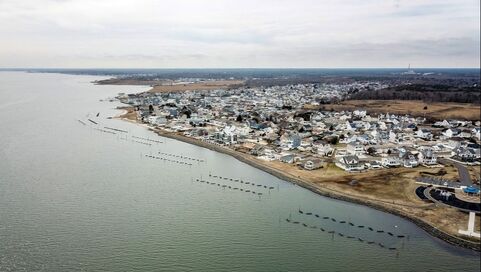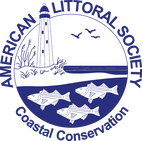Recycled Shells Heading Back to Bay As Littoral Society Completes Forked River Restoration Project10/12/2023
After years of collecting shells, we're ready to return a significant amount of them to a New Jersey bay in what will be the American Littoral Society's first use of recycled shells in a major restoration project. The shells will be moved from our curing site on Sandy Hook (inside Gateway National Recreation Area) to our Forked River Beach living shoreline restoration project in Lacey Township, NJ on Thursday, October 12. The transportation will also highlight a great public-private partnership, with the construction company currently working on the bridge between Rumson and Sea Bright (Richard E. Pierson Construction Co., Inc.) volunteering to load the shell from the curing site into a truck provided by Lacey Township. “This is a perfect example of how a public/private partnership should work,” said Capt. Al Modjeski, Habitat Restoration Program Director for the American Littoral Society. “It shows true project cohesiveness and that we all have the ability to care for the coast by and improve ecology, habitat, and community resiliency.” The installation of the shells from the Littoral Society's "Shuck It, Don't Chuck It!" (SIDCI) program (on October 16-17) and a volunteer event on Wednesday, October 18, will also mark the completion of the project to protect homes and habitat along an eroding section of Barnegat Bay shoreline. The project, which entailed building reef segments that have been seeded with 32 million live oyster, began in 2021 with the help of partners and funders including: the New Jersey Department of Environmental Protection (NJDEP), New Jersey Corporate Wetlands Restoration Partnership, Lacey Township, Bayside Beach Club, Stockton University, Albert Marine Construction, the US Fish & Wildlife Service, ReClam the Bay, Parsons Seafood, and Wildlife Restoration Partnerships.  “We are closing the ecological and program loops by returning these shells to the bay,” said Tim Dillingham, Executive Director of the Littoral Society. “It is in many ways a circular ecology and economy building effort. These shells are going back in the water to promote re-oystering our waters, provide habitat for fish and other marine species and help in reducing the vulnerability of a shorefront community.” Historically, Barnegat Bay had over 12,000 acres of eastern oyster beds. Today, nearly the entire natural oyster population is gone. With their elimination, Barnegat Bay not only lost the oysters themselves, but the things they did for the bay such as reducing the force of waves on shorelines, filtering water, reducing turbidity, and providing living space for other marine life. The disappearance of oysters – and the reefs they build – hit home in the Forked River Beach community, as erosion reached a point that the bay was flowing into some homes during high tides. The site has lost more than 150 feet of shoreline since 1995, with erosion accelerating after Superstorm Sandy in 2012. Increased sediment in water from shoreline erosion has also impacted the water quality of Barnegat Bay. To stabilize the shoreline and reduce the amount of sediment in the water, the Littoral Society designed a project that would include 168 reef segments running along the Forked River Beach shoreline from the mouth of the Forked River in the north, near Bayfront Park, to a lagoon located at the southern end of Beach Boulevard. Each segment was hand-built by volunteers to approximately 12 feet long by 5 feet wide and 4 feet high. The reef segments consist of HESCO units, which are portable protective barriers often used by the US military. The four-foot-by-three-foot steel wire crates can be filled with various kinds of material - from dirt or sand to rock and shell. For this project, each HESCO unit/reef segment is three connected galvanized steel baskets surrounded by eight outer pockets filled with shell. The interior baskets contain rock to help keep them in place. The final five inshore reefs will be completed on October 16 and 17. The shell faces on these HESCO baskets will be filled with 60 cubic yards of shell (about two dump trucks full) from the SIDCI shell recycling curing site and an additional six truckloads donated by Albert Marine. The shell recycling program was launched in 2015 with the help of restaurants in Monmouth and Ocean counties that set aside used shells for collection by Littoral Society staff and our Oyster Wrangler volunteers. At the curing site, mother nature and sunshine remove organic material and bacteria from the shells, so they are ready for use in restoration projects. Over the years, the shell recycling program has expanded to include community drop-off sites in Rumson and Point Pleasant Beach, NJ. Since the start, more than 32 tons of shell have been collected. The oyster shell recycling program is supported through grants from the Marta Heflin Foundation and NOAA Fisheries. The program is also focused on promoting our aqua-culture partners at the Barnegat Oyster Collective.
Mae Ann Henderson
10/22/2023 01:13:46 pm
Thank you to all contributors of shells. You are helping save the coastline and inland low lands. You will be appreciated for years to come. Please keep up this important work. Comments are closed.
|
Archives
July 2024
Categories
All
|

